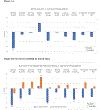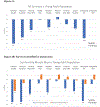Frail young adult cancer survivors experience poor health-related quality of life
- PMID: 35319782
- PMCID: PMC9133201
- DOI: 10.1002/cncr.34196
Frail young adult cancer survivors experience poor health-related quality of life
Abstract
Background: Young adult cancer survivors experience frailty and decreased muscle mass at rates equivalent to much older noncancer populations, which indicate accelerated aging. Although frailty and low muscle mass can be identified in survivors, their implications for health-related quality of life are not well understood.
Methods: Through a cross-sectional analysis of young adult cancer survivors, frailty was assessed with the Fried frailty phenotype and skeletal muscle mass in relation to functional and quality of life outcomes measured by the Medical Outcomes Survey Short-Form 36 (SF-36). z tests compared survivors with US population means, and multivariable linear regression models estimated mean SF-36 scores by frailty and muscle mass with adjustments made for comorbidities, sex, and time from treatment.
Results: Sixty survivors (median age, 21 years; range, 18-29) participated in the study. Twenty-five (42%) had low muscle mass, and 25 were either frail or prefrail. Compared with US population means, survivors reported worse health and functional impairments across SF-36 domains that were more common among survivors with (pre)frailty or low muscle mass. In multivariable linear modeling, (pre)frail survivors (vs nonfrail) exhibited lower mean scores for general health (-9.1; P = .05), physical function (-14.9; P < .01), and overall physical health (-5.6; P = .02) independent of comorbid conditions.
Conclusions: Measures of frailty and skeletal muscle mass identify subgroups of young adult cancer survivors with significantly impaired health, functional status, and quality of life independent of medical comorbidities. Identifying survivors with frailty or low muscle mass may provide opportunities for interventions to prevent functional and health declines or to reverse this process.
Lay summary: Young adult cancer survivors age more quickly than peers without cancer, which is evidenced by a syndrome of decreased resilience known as frailty. The relationship between frailty (and one of its common components, decreased muscle mass) and quality of life among young adult cancer survivors was examined. Measuring decreased muscle mass and frailty identifies young survivors with poor quality of life, including worse general health, fatigue, physical function, and overall physical health, compared with nonfrail survivors. Interventions to address components of frailty (low muscle mass and weakness) may improve function and quality of life among young adult cancer survivors.
Keywords: adolescents; cancer survivorship; frailty; health-related quality of life; muscle mass; young adults.
© 2022 American Cancer Society.
Conflict of interest statement
Figures




Similar articles
-
Physiologic Frailty and Neurocognitive Decline Among Young-Adult Childhood Cancer Survivors: A Prospective Study From the St Jude Lifetime Cohort.J Clin Oncol. 2021 Nov 1;39(31):3485-3495. doi: 10.1200/JCO.21.00194. Epub 2021 Jul 20. J Clin Oncol. 2021. PMID: 34283634 Free PMC article.
-
Frailty and Comorbidities Among Survivors of Adolescent and Young Adult Cancer: A Cross-Sectional Examination of a Hospital-Based Survivorship Cohort.J Adolesc Young Adult Oncol. 2018 Jun;7(3):374-383. doi: 10.1089/jayao.2017.0103. Epub 2018 Mar 23. J Adolesc Young Adult Oncol. 2018. PMID: 29570988 Free PMC article.
-
Screening for Frailty Using the FRAIL Scale in Older Cancer Survivors: A Cross-sectional Comparison With the Fried Phenotype.Semin Oncol Nurs. 2024 Apr;40(2):151617. doi: 10.1016/j.soncn.2024.151617. Epub 2024 Feb 28. Semin Oncol Nurs. 2024. PMID: 38423822
-
Effects of physical activity interventions in frail and prefrail community-dwelling people on frailty status, muscle strength, physical performance and muscle mass-a narrative review.Wien Klin Wochenschr. 2019 Jun;131(11-12):244-254. doi: 10.1007/s00508-019-1484-7. Epub 2019 Apr 2. Wien Klin Wochenschr. 2019. PMID: 30941525 Free PMC article. Review.
-
Cancer-treatment-induced accelerated aging in older adult cancer survivors: A call for actions for future perspectives in geriatric oncology.Arch Gerontol Geriatr. 2025 Jul;134:105858. doi: 10.1016/j.archger.2025.105858. Epub 2025 Apr 8. Arch Gerontol Geriatr. 2025. PMID: 40287988 Review.
Cited by
-
Frailty in middle-aged and older adult postoperative patients with gynecological malignancies structural equation modeling.Front Public Health. 2024 Sep 26;12:1431048. doi: 10.3389/fpubh.2024.1431048. eCollection 2024. Front Public Health. 2024. PMID: 39391154 Free PMC article.
-
A predictive model for neoadjuvant therapy response in breast cancer.Metabolomics. 2025 Feb 20;21(2):28. doi: 10.1007/s11306-025-02230-6. Metabolomics. 2025. PMID: 39979511
-
A scoping review evaluating physical and cognitive functional outcomes in cancer survivors treated with chemotherapy: charting progress since the 2018 NCI think tank on cancer and aging phenotypes.J Cancer Surviv. 2024 Aug;18(4):1089-1130. doi: 10.1007/s11764-024-01589-0. Epub 2024 May 14. J Cancer Surviv. 2024. PMID: 38743185 Free PMC article.
-
Nicotinamide riboside intervention alleviates hematopoietic system injury of ionizing radiation-induced premature aging mice.Aging Cell. 2023 Nov;22(11):e13976. doi: 10.1111/acel.13976. Epub 2023 Aug 31. Aging Cell. 2023. PMID: 37650560 Free PMC article.
-
Behavior change techniques in physical activity and dietary interventions among adolescent and young adult cancer survivors: a systematic review and meta-analysis of randomized controlled trials.J Cancer Surviv. 2025 Jun 27. doi: 10.1007/s11764-025-01836-y. Online ahead of print. J Cancer Surviv. 2025. PMID: 40571848 Review.
References
-
- American Cancer Society. Cancer Treatment & Survivorship Facts & Figures 2019–2021. Atlanta: American Cancer Society, 2019.
Publication types
MeSH terms
Grants and funding
LinkOut - more resources
Full Text Sources
Medical

